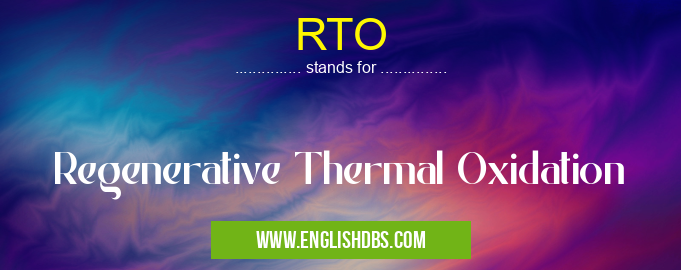What does RTO mean in UNCLASSIFIED
Regenerative Thermal Oxidation (RTO) is an air pollution control technology used to reduce volatile organic compounds (VOCs) and hazardous air pollutants (HAPs) from industrial processes. RTOs operate on the principle of thermal oxidation, where VOCs and HAPs are destroyed by reacting them with oxygen at high temperatures.

RTO meaning in Unclassified in Miscellaneous
RTO mostly used in an acronym Unclassified in Category Miscellaneous that means Regenerative Thermal Oxidation
Shorthand: RTO,
Full Form: Regenerative Thermal Oxidation
For more information of "Regenerative Thermal Oxidation", see the section below.
How RTO Works
RTOs consist of a combustion chamber, a heat exchanger, and a blower. The polluted air stream is drawn into the combustion chamber, where it is heated to a high temperature (typically 1200-1800°F) in the presence of oxygen. This high temperature causes the VOCs and HAPs to oxidize, converting them into harmless compounds such as carbon dioxide and water vapor.
Heat Recovery and Energy Conservation
One of the key features of RTOs is their ability to recover heat from the combustion process. The hot gases exiting the combustion chamber pass through a heat exchanger, where they transfer their heat to the incoming polluted air stream. This heat recovery significantly reduces the energy required to operate the RTO, resulting in energy savings.
Applications of RTO
RTOs are widely used in various industries, including:
- Chemical manufacturing: To control emissions from chemical reactions and processes.
- Pharmaceutical manufacturing: To destroy VOCs and HAPs generated during drug production.
- Printing and packaging: To reduce emissions from printing presses and coating processes.
- Food and beverage processing: To control odors and VOCs from food processing operations.
Benefits of RTO
- High destruction efficiency: RTOs achieve destruction efficiency rates of up to 99.99%.
- Energy conservation: Heat recovery features significantly reduce energy consumption.
- Low operating costs: RTOs have low maintenance and operating costs compared to other air pollution control technologies.
- Compact design: RTOs have a compact design, making them suitable for use in space-constrained areas.
Essential Questions and Answers on Regenerative Thermal Oxidation in "MISCELLANEOUS»UNFILED"
What is Regenerative Thermal Oxidation (RTO)?
RTO is an air pollution control technology that uses thermal energy to oxidize and break down volatile organic compounds (VOCs) and hazardous air pollutants (HAPs) present in industrial exhaust gases. It involves heating the polluted air to a high temperature (typically 1,400-1,800°F) in a combustion chamber, where the contaminants are oxidized and converted into carbon dioxide and water vapor. The cleaned air is then released into the atmosphere, while the heat generated during the oxidation process is recovered and reused to preheat the incoming polluted air.
How does an RTO system work?
An RTO system consists of two or more ceramic heat exchange beds filled with a special ceramic material that can withstand high temperatures. The polluted air passes through the first bed, where it is preheated by the heat stored in the ceramic material. The preheated air then enters the combustion chamber, where it is mixed with natural gas or another fuel and ignited. The contaminants in the air are oxidized and broken down at the high temperature. The hot, cleaned air then passes through the second heat exchange bed, transferring its heat to the ceramic material. This heat is then used to preheat the incoming polluted air, making the process highly energy-efficient.
What are the advantages of using RTO?
RTO technology offers several advantages, including:
- High destruction efficiency: RTOs can achieve destruction removal efficiencies (DREs) of 99% or higher for a wide range of VOCs and HAPs.
- Energy efficiency: The heat generated during the oxidation process is recovered and reused to preheat the incoming polluted air, resulting in significant energy savings.
- Low maintenance: RTOs are relatively low maintenance, with no moving parts or filters to replace.
- Compact design: RTO systems are typically compact and can be easily integrated into existing industrial facilities.
What are the applications of RTO?
RTOs are commonly used in various industries to control air pollution, including:
- Chemical manufacturing
- Pharmaceutical manufacturing
- Printing and packaging
- Food and beverage processing
- Semiconductor manufacturing
- Metal finishing
Final Words: Regenerative Thermal Oxidation (RTO) is an effective and energy-efficient technology for reducing VOC and HAP emissions from industrial processes. Its high destruction efficiency, combined with heat recovery capabilities and low operating costs, make it an attractive choice for various industries seeking to comply with environmental regulations and improve air quality.
RTO also stands for: |
|
| All stands for RTO |
